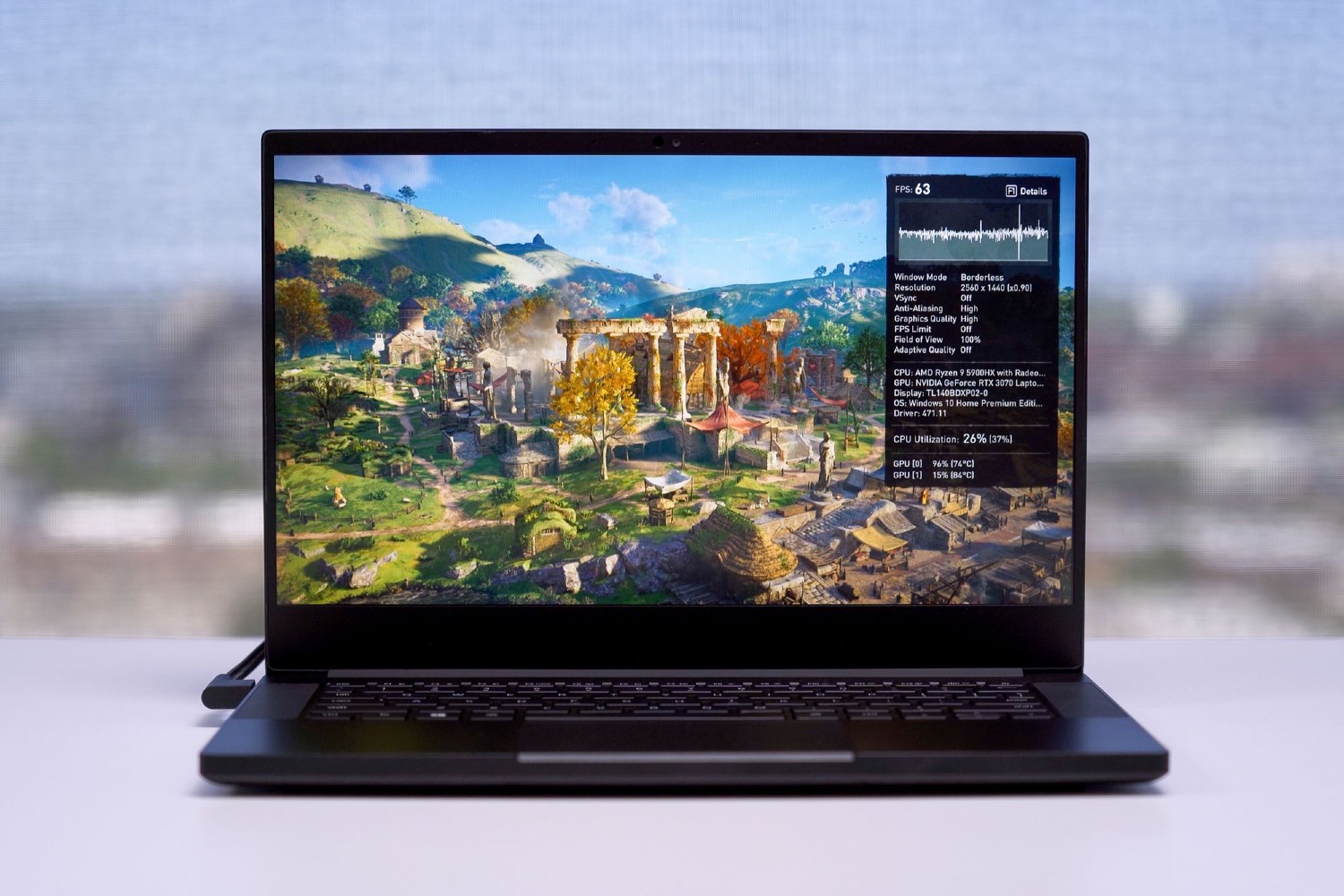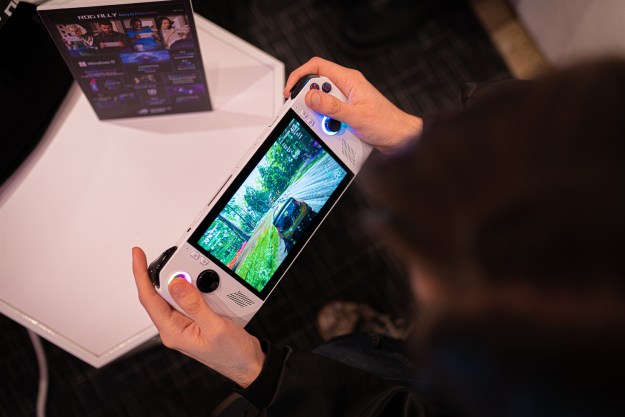Most gaming laptops are based around 15-inch displays or larger, in part to fit in high-end components with lots of room for moving air around to keep things cool. But they’re also typically larger machines (natch), which aren’t as easy to carry around. That’s where the 14-inch gaming laptop comes in, although it remains a rarer breed.
Two of the best are the Razer Blade 14 and the Asus ROG Zephyrus G14. They both offer smaller chassis with serious gaming chops stuffed inside. Which of these two relatively diminutive
Specs
| Razer Blade 14 | Asus ROG Zephyrus G14 | |
| Dimensions | 12.59 inches x 8.66 inches x 0.66 inches | 12.76 inches x 8.66 inches x 0.70 inches |
| Weight | 3.92 pounds | 3.53 pounds |
| Processor | AMD Ryzen 9 5900HX | AMD Ryzen 7 4800HS AMD Ryzen 9 4900HS |
| Graphics | Nvidia GeForce RTX 3060 Nvidia GeForce RTX 3070 Nvidia GeForce RTX 3080 |
Nvidia GeForce GTX 1660 Ti Max-Q Nvidia GeForce RTX 2060 Max-Q |
| RAM | 16GB | 16GB |
| Display | 14.0-inch Full HD (1,920 x 1,080) IPS 144Hz 14.0-inch QHD (2,560 x 1,440) IPS 165Hz |
14.0-inch Full HD IPS 120Hz 14.0-inch QHD IPS 60Hz |
| Storage | 1TB solid-state drive | 512GB SSD 1TB SSD |
| Touch | Optional | No |
| Ports | 2 x USB-A 3.2 Gen 2 2 x USB-C 3.2 Gen 2 1 x HDMI 2.1 3.5mm audio jack |
2 x USB-A 3.2 Gen 1 2 x USB-C 3.2 Gen 2 1 x HDMI 2.0b 1 x 3.5mm audio jack |
| Wireless | Wi-Fi 6 and Bluetooth 5 | Wi-Fi 6 and Bluetooth |
| Webcam | 720p | 720p |
| Operating system | Windows 10 Home | Windows 10 Home Windows 10 Pro |
| Battery | 61.6 watt-hour | 76 watt-hour |
| Price | $1,800+ | $1,300+ |
| Rating | 4.5 out of 5 stars | 3.5 out of 5 stars |
Design

The Razer Blade 14 enjoys the same beautiful all-black aluminum chassis, with only the green Razer snake logo on the lid to break up the color scheme. You won’t find the typical gaming laptop’s aggressive lines or massive vents that evoke images of jet fighters — the Blade 14 is as comfortable to use in a conference room as a LAN party. The Asus ROG Zephyrus G14 looks more like a gaming laptop, with the company’s optional AniMe Matrix Display LED lighting on the lid — white dots adorn the lid when the matrix isn’t installed — and vents that are far more numerous and ostentatious than the Razer’s. The Zephyrus G14’s color scheme is also a bit mixed up, with a white lid, gray keyboard deck and chassis, and black display bezels. The look fits the gamer aesthetic, but it’s not as flat-out attractive as the Blade 14.
As mentioned, the Blade 14 is an all-aluminum laptop, and it’s solid as a rock. You’ll find no bending, flexing, or twisting anywhere in the machine. The Zephyrus G14 is constructed of magnesium alloy, which tends to be a little less solid than aluminum. We won’t fault the Asus for its build quality, but the Razer is hard to match.
The Blade 14 comes in at 12.59 inches wide by 8.66 inches deep by 0.66 inches thick, and it weighs 3.92 pounds. The Zephyrus G14 is 12.76 inches wide by 8.66 inches deep by 0.70 inches thick, and it weighs 3.53 pounds. The two laptops are almost identical in terms of their size, with the Blade 14 being slightly thinner. At the same time, the Zephyrus G14 is almost half a pound lighter. It’s hard to give either laptop the win here — they’re both very small machines for how powerful they are (which we’ll discuss below).
Although the Razer Blade 14’s overall design is less like the typical gaming laptop, it does pack a more gamer-oriented keyboard. It offers per-key RGB backlighting that’s highly customizable, along with 15 levels of brightness (unheard of in Windows 10 laptops). The Zephyrus G14, on the other hand, eschews the usual gamer options here and has just single-zone backlighting that’s not customizable, and the lighting is inconsistent across keys. Not only does the Blade 14 offer a more dynamic keyboard, but it also has a much better feel compared to the Zephyrus G14, which we found to be mushy. However, both
Finally, connectivity is almost identical between the two laptops. Both have two USB-A 3.2 ports, although both of the Blade 14’s are Gen 2, and both have two USB-C 3.2 Gen 2 ports. The full-size HDMI port on the Blade 14 is version 2.0 compared to the 2.0b HDMI port on the Zephyrus G14. And both have 3.5mm audio jacks. Wi-Fi 6 and Bluetooth 5.0 provide for wireless connectivity duties on both.
Performance

The Zephyrus G14 and Blade 14 are both based around AMD Ryzen CPUs, the Ryzen 9 5900HX in the Razer, and either the Ryzen 7 4800HS or Ryzen 9 4900HS in the Asus (which was in our review unit). Processor performance was similar, with the Zephyrus G14 being a little faster in the Geekbench 5 multi-core score and the Blade 14 being faster in single-core mode. Unfortunately, we didn’t test both laptops in the same version of Handbrake, and we didn’t test the Zephyrus G14 in Cinebench R23 — thus limiting our ability to compare their processor performance. It’s likely, though, that the Blade 14 would have been significantly faster thanks to its Ryzen 5000-series CPU, not to mention the Zephyrus G14 using the slower “HS” model of the Ryzen 4000 series that’s meant to run cooler in thin chassis — making the Blade 14 the better machine for demanding tasks like video editing.
Gaming is naturally faster on the Blade 14, which uses Nvidia GeForce RTX 3000 series GPUs (we tested with the RTX 3070). The Zephyrus G14 scored 5,861 on the 3DMark Time Spy test with its Nvidia GeForce RTX 2060, compared to the Blade 14’s 8,605. The Asus managed 91 frames per second (fps) in Civilization VI at 1080p and ultra graphics, where the Blade 14 hit 111 fps. In Battlefield V, the Zephyrus G14 achieved 70 fps at 1080p and ultra graphics, while the Blade 14 hit 96 fps. Finally, just for kicks, the Zephyrus G14 hit 91 fps in Fortnite at 1080p and epic graphics, where the Blade 14 managed 96 fps — not that much faster.
The Blade 14 and the Zephyrus G14 are great performers for 14-inch laptops, capable of 1440p gaming (with the right display) at high frame rates even with graphics turned up. That’s quite the achievement for smaller
Display

The Blade 14 offers a choice between a Full HD (1,920 x 1,080) display running at 144Hz or a QHD (2,560 x 1,440) display running at 165Hz. It compares to the Zephyrus G14 with 120Hz Full HD and 60Hz QHD options. Clearly, you’re getting a more gaming-oriented display with the Blade 14, no matter which option you choose.
We tested the Blade 14’s QHD display and found it to offer surprisingly good color support at 90% of AdobeRGB and 100% of sRGB with color accuracy of DeltaE 1.54 (1.0 or less is excellent), which is very good for a gaming display. The contrast was just okay at 830:1 (we prefer 1,000:1 or better), and brightness just exceeded our 300-nit threshold at 315 nits. Our Zephyrus G14 review unit was equipped with the Full HD display, and it couldn’t match the Blade 14’s colors at 75% of AdobeRGB and 98% of sRGB with excellent color accuracy of 1.1. The contrast was similar at 880:1, and brightness as well at 332 nits.
Both displays offer quality images that would be well-suited for productivity-oriented premium laptops (even creators would love the colors on the Blade 14’s display). As
Portability

The Blade 14 is slightly thinner, and the Zephyrus G14 is a bit lighter, but both 14-inch laptops are small for gaming machines. Neither will weigh you down like the typical gaming laptop, slipping into your backpack and barely letting you know it’s there.
The Zephyrus G14 was equipped with a larger battery at 76 watt-hours, compared to the Blade 14’s 61.6 watt-hours. Note that the Razer we reviewed had a higher resolution display, which would skew battery results. Even so, the Blade 14 lasted for 8.25 hours, almost 1.5 hours longer than the Zephyrus G14 in our web browsing test and about an hour longer in our video looping test at 11 hours. Neither laptop should be expected to get you through a full day’s work, and, of course, you’ll want to keep your charger handy when you’re gaming — we’re likely talking about a few hours when the CPU and GPU are being taxed.
The Razer Blade 14 dominates, and not just against the Asus ROG Zephyrus G14
The Asus ROG Zephyrus G14 starts at $1,300 for a Ryzen 7 4800HS, 16GB of RAM, a 512GB SSD, a 14-inch Full HD display, and an Nvidia GeForce GTX 1660 Ti Max-Q. It tops out at around $2,100 for a Ryzen 9 4900HS, 16GB of RAM, a 1TB SSD, a QHD display, and an RTX 2060 GPU. It’s expensive, but as we’ll see, it’s significantly less expensive than its competitor here.
The Razer Blade 14 starts at $1,800 for a Ryzen 9 5900HX, 16GB of RAM, a 1TB SSD, a Full HD display, and an RTX 3060 GPU. It tops out at $2,800 with the QHD display at RTX 3080. It’s an expensive laptop.
No matter the cost, the Razer Blade 14 is a better-built, better-looking, and faster gaming laptop. It not only beats out the Asus ROG Zephyrus G14, which is a great laptop in its own right, but the Blade 14 is officially our favorite
Editors' Recommendations
- Best 14-inch laptops for 2024: tested and reviewed
- We just learned two critical details about the 2024 Zephyrus G14
- The new Razer Blade 16 is embracing OLED in a big way
- Asus’ forgotten ROG Ally is now totally worth the money
- This sleeper Asus laptop is faster and cheaper than Microsoft’s Surface Laptop Go 3


